
About UsThe Numismatic Bibliomania Society is a non-profit organization promoting numismatic literature. For more information please see our web site at coinbooks.org SubscriptionsThose wishing to become new E-Sylum subscribers (or wishing to Unsubscribe) can go to the following web page link MembershipThere is a membership application available on the web site Membership Application To join, print the application and return it with your check to the address printed on the application. Membership is only $15 to addresses in the U.S., $20 for First Class mail, and $25 elsewhere. For those without web access, write to: David M. Sundman, Treasurer AsylumFor Asylum mailing address changes and other membership questions, contact David at this email address: dsundman@LittletonCoin.com SubmissionsTo submit items for publication in The E-Sylum, just Reply to this message, or write to the Editor at this address: whomren@gmail.com
BUY THE BOOK BEFORE THE COIN |
- WAYNE'S WORDS: THE E-SYLUM FEBRUARY 2, 2014
- LAKE BOOKS’ 117TH MAIL-BID SALE CLOSES FEBRUARY 4, 2014
- BALDWIN'S WINTER 2013-2014 PRICE LIST OFFERS NUMISMATIC LITERATURE
- NEW BOOK: HISTORY OF THE CENTRAL STATES NUMISMATIC SOCIETY
- NEW BOOK: DOUBLE DIMES: THE U.S. TWENTY-CENT PIECE
- THE BROBSTON COLLECTION OF UNITED STATES HALF CENTS
- KEVIN GRANT, 1954-2014
- COINAGE OF THE ROMAN EMPIRE DATABASE (OCRE) EXPANDS
- HIGHLAND MINT'S SUPER BOWL FLIP COIN
- NOTES FROM E-SYLUM READERS: FEBRUARY 2, 2014
- MAN CAPTURES UNICORN: 1974-D ALUMINUM CENT
- MISSOURI CABINET OF U.S. HALF CENTS BRINGS $18 MILLION
- BILL ECKBERG'S MISSOURI CABINET DIARY
- SHOULD HISTORICAL MEDALS BE ENCAPSULATED?
- URSULA KAMPMANN VISITS THE ANS
- BYRON WESTON AND CONTEMPORARY COUNTERFEIT HALFPENCE
- COIN WORLD ARTICLE ON JOHN BURNS
- KRALJEVICH REMEMBERS JOHN BURNS
- THE BANK OF ENGLAND £1M AND £100M BANK NOTES
- THE SCOUT ASSOCIATION’S SILVER CROSS
- MAKING THE CODE TALKERS CONGRESSIONAL MEDALS
- ELECTRONIC PUBLISHING IN NUMISMATICS
- 1947 ACADEMY AWARD MEDAL AUCTIONED
- ERIC P. NEWMAN COLLECTION PART III SALE RESULTS
- NUMISMATIC POSTCARDS PICTURING U.S. COINS
- 300 DAYS OF FREE MEALS AND DRINKS
- FEATURED WEB PAGE: SATIRICAL COINS OF NAPOLEON III
Click here to access the complete archive
To comment or submit articles, reply to whomren@gmail.com
WAYNE'S WORDS: THE E-SYLUM FEBRUARY 2, 2014

New subscribers this week include Tim Shisler and Michael Connor. Welcome aboard! We have 1,691 email subscribers.
This week we open with a reminder from Fred Lake about this week's sale closing, a fixed price list including numismatic literature from Baldwin's, and two new books. Other topics include half cents, half cents and more half cents, the OCRE Roman coins database, and visits to Heritage, the Goldbergs, and ANS.
To learn more about electronic publishing in numismatics, the 100 million pound banknote, a numismatic unicorn, double dimes, the Code Talkers Congressional medals, difficulties whilst bathing and whether historical medals should be encapsulated, read on. Have a great week, everyone!
Wayne Homren
Editor, The E-Sylum
LAKE BOOKS’ 117TH MAIL-BID SALE CLOSES FEBRUARY 4, 2014
This is a reminder that Lake Books’ 117th mail-bid auction sale of numismatic literature will close on Tuesday, February 4, 2014 at 5:00 PM (EST). You may view the sale at - www.lakebooks.com/current.html. The 469-lot sale contains many fine hardbound catalogs of the major auction houses including a long run of the emissions of George F. Kolbe, reference works for Chinese coinage, paper money, tokens and medals, et al. Bids may be placed via email, FAX, or telephone.
Good Luck with your bidding, Fred
Lake Books
PMB 118
6822 22nd Ave. N
St. Petersburg, FL 33710-3918
727-343-8055 FAX: 727-381-6822
BALDWIN'S WINTER 2013-2014 PRICE LIST OFFERS NUMISMATIC LITERATURE
 Caroline Newton of Baldwin's in London writes:
Caroline Newton of Baldwin's in London writes:
Our new Fixed Price List was released on Friday and we have a fantastic book selection (courtesy of our lovely book specialist, Caroline Holmes). I’ve attached details of some of the highlights.
Baldwin’s Winter Fixed Price List 2013-14
Just under 900 items are offered in the latest Baldwin’s Fixed Price List, including selections of Ancient Greek, Roman and Byzantine coins as well as British coins from all periods, Anglo-Gallic, Scottish and Irish coinage, British Historical Medals and some wonderful Numismatic Books.
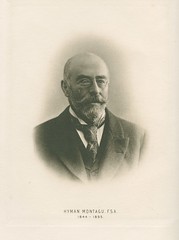 A beautifully bound and complete set of Montagu and Murdoch sales, from the library of one of the nineteenth century’s most prolific collectors, Cyril Lockett. Highly important and scarce, this set has the added attraction of being Lockett’s own and with his distinctive ex-libris on the first pastedown of each volume. Evidently used by Lockett as a working reference as the coins with a Montagu pedigree which were bought throughout his years collecting have been underlined with much care and attention in red ink. Locket managed to reunite well over 200 of some of Montagu’s most prestigious coins, (mostly Anglo-Saxon and early hammered with a number being unique and many more of extreme rarity), a quite remarkable achievement and something which simply would not be possible today.
A beautifully bound and complete set of Montagu and Murdoch sales, from the library of one of the nineteenth century’s most prolific collectors, Cyril Lockett. Highly important and scarce, this set has the added attraction of being Lockett’s own and with his distinctive ex-libris on the first pastedown of each volume. Evidently used by Lockett as a working reference as the coins with a Montagu pedigree which were bought throughout his years collecting have been underlined with much care and attention in red ink. Locket managed to reunite well over 200 of some of Montagu’s most prestigious coins, (mostly Anglo-Saxon and early hammered with a number being unique and many more of extreme rarity), a quite remarkable achievement and something which simply would not be possible today.
A unique manuscript from the library of Carlyon-Britton, listing his magnificent, and hitherto unknown, collection of English hammered gold. Carlyon-Britton (1863-1938) was a leading light in the numismatic world and alongside W. Andrew and L. A. Lawrence was a founding member of the British Numismatic Society. He wrote prolifically in, amongst others, the Numismatic Chronicle, Spink’s Numismatic Circular and particularly the British Numismatic Journal and many of his articles are still standard references today. The catalogues for his collections show that he was a collector with great taste and judgement and the preface to his 1913 sales states that he collected with “boundless patience and enthusiasm” and sold only because it was becoming increasingly difficult to add to, and not because his interest in the subject had waned.
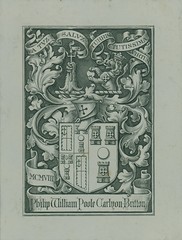 A large paper copy of the Durrant sale - priced and named and bound with the Campana sale.
A large paper copy of the Durrant sale - priced and named and bound with the Campana sale.
The collection of John Watkins Brett - the founder of submarine telegraphy.
A fantastic run of early and important auction catalogues many with distinguished provenances, along with a wonderful run of early Sotheby's and Christie’s sales from the library of Carlyon-Britton. Also included is the 1741-1742 Earl of Oxford Sale catalogue of the first major numismatic sale held in England.
To read the complete price list online, see:
FIXED PRICE LIST WINTER 2013-14
(www.baldwin.co.uk/fixedpricelistw201314/)
NEW BOOK: HISTORY OF THE CENTRAL STATES NUMISMATIC SOCIETY
Here are a few details about the "History of the Central States Numismatic Society" which I wrote to be released at the 75th Anniversary Convention of Central States, April 23-26, in the Renaissance Convention Center in Schaumburg, IL.
We produced 50 hard cover and 500 soft cover versions. The hard cover price is $30.00 postpaid . The soft cover is $6.00 postpaid. Buyers may pick up their books at the convention or ask to have them mailed. Also, I will autograph copies upon request.
The book traces the 75 year history of Central States from its 1939 beginning in Chicago to the present. It is arranged in a year-by-year format with details from every convention. The major feature of my book is emphasis on the people who worked to make Central States the great hobby organization it is today. Officers, committee members, dealers, exhibitors and friends are mentioned throughout the book. Famous names in our hobby proliferate the history of Central States. ANA officials were instrumental in founding Central States. Hobby leaders such as Richard Yeomans, Eric Newman, Lee Hewitt, J. Henri Ripstra, Harry X Boosel, and Dr. Walter Judd were early movers and shapers of Central States.
The book also highlights important CSNS Board decisions through the years that provided guidance to the officers, Board members and membership. Interesting glimpses of Board meetings and social events can be found throughout the book. Historical research is evident from such sources as Numismatic Scrapbook, The Numismatist, The Centinel and CSNS Board minutes.
The book was a labor of love and a story well-worth telling. In my summary statement I offer special thanks to those who helped me with the research and writing: Rollie Finner, Jerry Lebo, Kevin Foley, Bob Julian and Dr. F. Steven Epps, the first Central States historian.
My book will be on sale at our April convention and can be preordered by sending checks made out to CSNS to me at: Ray Lockwood 2075 E. Bocock Road - Marion, IN 46952. Thanks !
THE BOOK BAZARRE
NEW BOOK: DOUBLE DIMES: THE U.S. TWENTY-CENT PIECE
 The book, Double Dimes -- The United States Twenty-cent Piece, is nearing completion. By the 5th of
February, the majority of the web book will be online in draft form, at www.doubledimes.com. Much of it is there already, and most of the remaining material will be added in the next few days.
The book, Double Dimes -- The United States Twenty-cent Piece, is nearing completion. By the 5th of
February, the majority of the web book will be online in draft form, at www.doubledimes.com. Much of it is there already, and most of the remaining material will be added in the next few days.
Over the coming weeks, some final material, edits, and finishing will be completed.
Please check out the site and check back often as the reference is completed.
The print version is planned for Spring.
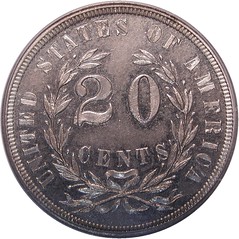 The comprehensive reference. A Web book, coming here at no cost in January 2014. This draft is posted for your convenience, as the authors complete the content and formatting for the Internet. Table of Contents is below.
The comprehensive reference. A Web book, coming here at no cost in January 2014. This draft is posted for your convenience, as the authors complete the content and formatting for the Internet. Table of Contents is below.
This book builds on the extensive experience of the authors, and their multiple decades of collecting this often-neglected and under-appreciated series. This highly-illustrated book presents new insights on 20-cent pieces, and offers the most comprehensive information ever assembled on all aspects of this short-lived coin. It is hoped that this reference will provide existing collectors with a wealth of new information, and instill interest and enthusiasm for an entire new set of collectors as well.
To read the draft book, see: www.doubledimes.com
THE BROBSTON COLLECTION OF UNITED STATES HALF CENTS
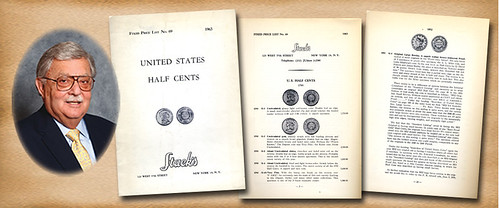
A specialized price list, covering an outstanding collection of United States half cents was issued in 1963. It featured the collection of Joseph Brobston of Nazareth, Pennsylvania, formed over close to a half a century. Many collections of this caliber and completeness had been formerly offered at public auction by Stack's. However, it was Mr. Brobston's request when we purchased this impressive half cent collection, that we endeavor to sell it intact to a single collector
The negotiations for the collection were handled by my uncle Joseph B. Stack and my father Morton Stack. Both were close friends of Joseph Brobston and they had a relationship of trust and friendship between them. After the deal was concluded on the telephone, I was dispatched to Nazareth to pick up the collection. Of course, in those days you didn’t find the coins housed in sealed plastic holders, but Mr. Brobston had them stored in old-fashioned 5 x 8 loose-leaf pages. These he hand-lettered to show the date and variety, and sometimes a special note about the specimen. He always wanted to be able to remove a coin from its holder and examine it up close. In that way he could study varieties and admire the beauty that copper reveals when examined under incandescent light. The closeness he felt to his coins cannot be fully described, but it was evident that a bond existed between him and each coin he possessed
During that period in 1963 there were a number of copper coin collectors in the hobby, many had formed outstanding collections of both half cents and large cents. The Brobston Collection was the envy of most of them.
There were 50 Proof coins, including the 1811 and 1852 Original. Many others were in choice Mint State, highlighted by the 1796 With Pole. We suggested that collectors who simply wanted to acquire a perfect example of this denomination, could readily achieve their goal through this collection. In the price list we remarked "each piece described is a single specimen, and that as many alternates selections as possible should be included with each order." The response was unbelievable, and we did our upmost to satisfy each request.
According to the records available at the time, the collection was virtually complete. Among the highlights it had five 1793's, 13 1794's, 15 1795's, both 1796's with the Pole to Cap in Gem Mint State, and eight 1797's, From 1800 to 1857 it included virtually all varieties known, highlighted by 1811 Proof, l831 Original, three First Restrikes and one Second Restrike all in Proof. Virtually all the Proof varieties from 1832 to 1857, Originals and Restrikes, were there, highlighted by an 1852 G-1 Large Berries Proof. It would have been a difficult assemblage to duplicate!
Harvey adds:
I am doing my best to recall those who I knew that contributed to the hobby, collector and dealer alike, and reflect back how when I can they each or all influenced me. Since few , if at all, remember or met many of the "old timers," I felt that this would add to value.
I always had to know the collector personally and then I could recall them and that would be part of the pedigree that stays with the coins.
To read the complete article, see: A 1963 Specialized Price List (www.stacksbowers.com/NewsMedia/Blogs/TabId/780/ArtMID/2678/ArticleID/64325/A-1963-Specialized-Price-List.aspx)
KEVIN GRANT, 1954-2014
John Mutch writes:
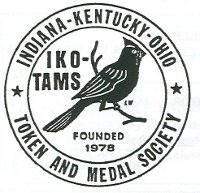 Kevin Grant, Bulletin Editor/Publisher and Maverick Editor for IKO-TAMS, passed away on Monday. He was also working on an update to Lloyd Wagaman's Indiana Trade Tokens.
Kevin Grant, Bulletin Editor/Publisher and Maverick Editor for IKO-TAMS, passed away on Monday. He was also working on an update to Lloyd Wagaman's Indiana Trade Tokens.
Kevin said in the last issue of the IKO-TAMS Bulletin that he was going to have to step down from editing and publishing the Bulletin, but so far, no member has stepped up to take on that job. Dave Gossett, the President, would really like to have somebody volunteer - his e-mail is sue26gossett@donet.com
I have been put in the position of resigning from my post of Editor. While I would have loved to continue the job, an uncertain future health-wise (stage 4 melanoma) dictates that I step aside now rather than down the road.
It has already affected the timing of this issue, being about a month late, as I struggle to get through the chemo treatments (I will have had the last one by the time you read this) while trying to still fulfill my job responsibilities at school. I have told President Gossett I will somehow continue to edit the Bulletin if a replacement cannot be found. However, if a replacement is not found there will come a time when issues will not be arriving in mailboxes.
If you have a commitment to seeing this arm of our organization continue, please consider contacting Dave for more details. When I volunteered back in 2005, my only qualifications were the desire to do my part for the hobby and the word processing skills to put together a newsletter of this type. I had never done anything like this before and would have never imagined myself in this position (my training is decidedly not in the arena of desktop publishing). I was actually expecting then President Jack Siles to turn down my offer due to lack of experience on my part.
Once taking the job, I found it was easier than I first imagined. For me, the hard part is not in the technical details, but in waiting for articles to show up in my email inbox or my physical mailbox. Due to the generosity of the members, I have yet to publish a Bulletin without at least one article of interest to the membership, and the cupboard is not bare. I have two members promising articles, one that I have done the research for, a lead on a multipart story, and two or three in hand and ready to go.
I am also now out of the collecting business. While I want to continue doing the research, I do not want to burden my wife with the dispersement of my collection. Look for my tables at the next IKO Show, October 10-11, 2014. You don’t know how much I missed being at the Show this year. Thank you for all of your thoughts and prayers on my behalf.
To read the complete article, see: ikotams.tokencatalog.com/pdfs/vol%2036%20issue%204%20--%202013.pdf
To visit the IKO-TAMS web site, see: ikotams.tokencatalog.com/
To read Kevin's obituary, see: Kevin Grant, 60 (www.thepostandmail.com/content/kevin-grant-60)
EMPLOYMENT OPPORTUNITY!
Live and Work in Southern CaliforniaStack’s Bowers Galleries offers an important employment opportunity for the right person. We are seeking an experienced numismatist in the American series—coins, tokens, medals, and paper money—to work with our “dream team” of catalogers, building on the tradition of the Ford, Eliasberg, Bass, Cardinal, Norweb, Battle Born and other great collections.
If you can write in an authoritative and compelling manner with a high degree of accuracy, this may be just right for you! You will be working in Irvine, a modern community in dynamic Orange County, California—one of the finest areas to live. We offer generous benefits including medical and dental coverage, 401K plan, and more. Our offices are in our own modern, state-of-the art building with all amenities.
If you would like to be considered for this position please contact Q. David Bowers by mail or by email with your resumé, samples of your past writing (on numismatics or other subjects), and salary requirements: Mail to the attention of Q. David Bowers, PO Box 1804, Wolfeboro, NH 03894. Email to: Ckarstedt@stacksbowers.com
COINAGE OF THE ROMAN EMPIRE DATABASE (OCRE) EXPANDS
In collaboration with New York University’s Institute for the Study of the Ancient World, the American Numismatic Society (ANS) is pleased to announce the release of a new version of OCRE (Online Coins of the Roman Empire) (numismatics.org/ocre/).
The OCRE project is creating a revolutionary new tool designed to help in the identification, cataloguing, and research of the rich and varied coinage of the Roman Empire. It aims to provide a comprehensive online resource encompassing every known Roman Imperial coin type. The end result will be:
- A database of 50,000 coin types
- A resource that collectors can use to identify their coins, estimate their rarity, and discover unknown varieties.
- An online reference tool for researchers to help in new research on this important series.
- Easy to use, downloadable catalogue entries for the coinage of every Roman Emperor from Augustus in 31 BC, until the death of Zeno in AD 491.
The new version of the tool contains important new improvements.
OCRE’s first version drew only on the collection of the American Numismatic Society, but the database now has multiple contributing collections, with the addition of the Roman Imperial collection of the Münzkabinett of the State Museum of Berlin and the University of Virginia Art Museum. Between these three collections, OCRE is now able to illustrate 50% of the imperial coin types that it contains. “Such a joint collaborative effort between major public and private collections should lead to a comprehensive catalogue that will eventually incorporate and display almost all recorded Roman Imperial coin-‐types,” explains ANS Executive Director, Ute Wartenberg Kagan. More collections will follow soon, bringing OCRE closer to that aim.
Along with adding new specimens, the database has grown since its launch in July 2012 to contain descriptions of known types through the emperor Septimius Severus. To date, more than 15,000 coin types are described. “The time range covered by OCRE is now incorporating 250 years of monetary and numismatic history, from 30 BC until AD 211, effectively covering the entire High Empire. We should very soon include the entire Severan dynasty and then the later 3rd century,” explains OCRE project manager, ISAW Research Associate and ANS Romanist, Gilles Bransbourg.
To read the complete press release, see: OCRE – Online Database of Coinage of the Roman Empire becomes Bigger, Multi-‐Contributor and Multi-‐Lingual (numismatics.org/wikiuploads/NewsEvents/2014_0127_PR_OCRE_.pdf)
HIGHLAND MINT'S SUPER BOWL FLIP COIN
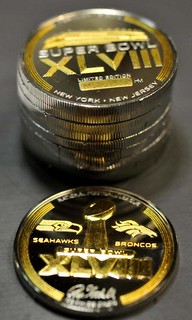 Michael Kott, head of The Highland Mint in Melbourne, doesn’t really care who wins the Super Bowl coin toss.
Michael Kott, head of The Highland Mint in Melbourne, doesn’t really care who wins the Super Bowl coin toss.
For that matter, he’s not all that concerned who is victorious in the match-up between the Denver Broncos and the Seattle Seahawks on Sunday.
As the manufacturer of the coin that is used in the Super Bowl toss, deciding which team kicks off and which team receives, Kott just wants plenty of sales — and exposure — for The Highland Mint.
The coin used in the flip will end up in Canton, Ohio, at the Professional Football Hall of Fame, while the Highland Mint will sell commemorative replicas to the public for $99.99
“This year we’re fortunate,” Kott said, “because from preliminary indications we’re getting from both cities, the interest is tremendously strong.”
Since opening nearly a quarter-century ago, the privately held Highland Mint has been building a sports commemorative company that makes coins and other products for all major sporting events, as well as theme parks owned by Disney and Universal.
But it’s the Super Bowl coin that gives the company, which employs about 120 people, its biggest exposure.
The mint not only makes the Super Bowl flip coin but also the remaining 99 coins, of the first 100 coins pressed, that go to players and NFL dignitaries. The rest — about 9,900 — are sold to the general public.
The coins, made of silver with gold highlights, usually sell out.
To read the complete article, see: Melbourne's Highland Mint has already won the Super Bowl coin toss (www.floridatoday.com/article/20140130/BUSINESS/301300031/Melbourne-s-Highland-Mint-has-already-won-Super-Bowl-coin-toss)
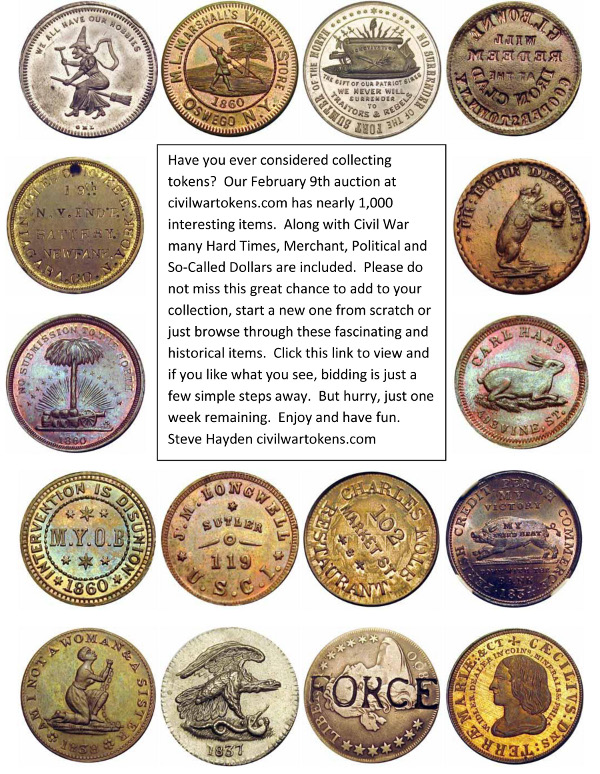
NOTES FROM E-SYLUM READERS: FEBRUARY 2, 2014
More On the Non-Collectible Designation James Higby writes:
As I understand the NC designation for large cents, it applies only to the early date die pairs (1793-1814) which were numbered sequentially from 1 to 295 by William Sheldon, leaving no room for new discoveries. NC then originally meant "not catalogued" and the first such discovery coin for a given date was given a designation such as 1793 NC-1.
Since these same coins had escaped detection for a century and a half, they were de facto in such short supply that collectors, desiring "complete" sets of large cents could define "complete" as being all 295 of the varieties that Sheldon had catalogued, while considering all the NCs as being "non-collectible." Newcomb, by contrast, started the numbering over with each change of date, thereby avoiding the "NC" dilemma.
As far as Civil War tokens go, I'm pleased that WI 510D will soon be NC (in this case, non-contemporary), but I'm equally afraid that WI 510J will remain NC (non-collectible, as in FBMR - forever beyond my reach).
Donald Erlenkotter writes:
To complicate matters further, there already is an NC designation used for Civil War tokens. It stands for "non-contemporary" - i.e., tokens that were struck either before 1860 or after 1864, outside the period of the Civil War. See the Fulds' U.S. Civil War Store Cards, Second Edition, 1985, pp. 589-599.
To read the earlier E-Sylum article, see: On the Non-Collectible Designation (www.coinbooks.org/esylum_v17n04a09.html)
Navigating Atlanta Ice I asked Dennis Tucker of Whitman Publishing how their office fared with the ice storm this week. He writes:
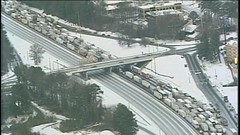 We all survived, with varying degrees of inconvenience! I live two miles away from the office, so my commute home on Tuesday was a “mere” 20 minutes. Our CFO, meanwhile, took 25 hours to get home. Office closed on Wednesday. . . skeleton crew on Thursday. . . and pretty much back up and running on Friday!
We all survived, with varying degrees of inconvenience! I live two miles away from the office, so my commute home on Tuesday was a “mere” 20 minutes. Our CFO, meanwhile, took 25 hours to get home. Office closed on Wednesday. . . skeleton crew on Thursday. . . and pretty much back up and running on Friday!
Fans of the zombie-apocalypse TV series “The Walking Dead” (filmed here in Atlanta) were struck by I-85’s resemblance to the show, with traffic stopped and cars abandoned.
To view some images of the Atlanta traffic, see: Roads continue to be affected by ice, snow (www.myfoxatlanta.com/story/24566305/massive-traffic-delays-reported-all-across-metro-area#axzz2s7fxmaAY)
Esquire Profile of Author Robert Caro From Wisconsin, where the wind chill hit 45 below, Jeff Reichenberger writes:
I was given the book, "The Best American Magazine Writing 2013" as a Christmas gift. Within it is the story by Chris Jones "The Big Book" for Esquire Magazine. There is nothing numismatic about the article, however, I believe it will interest bibliophiles. It is the story of Pulitzer Prize winning author Robert Caro, his amazing research and writing mechanics, his continuing opus about Lyndon Johnson, the world of big-time publishing and how it has changed over the course of 30 plus years he has been writing the Johnson saga, and the making of books then and now.
To read the complete article, see: The Big Book (www.esquire.com/print-this/robert-caro-0512?page=all)
The Mysteries of Don Taxay Dave Lange writes:
Mention of Don Taxay in connection with George Kolbe's article in The Numismatist reminded me of a television show I caught a week or two ago. The series Mysteries at the Museum did a segment on the 1913 Liberty Head nickel held by the ANA Museum and the story behind the five known coins. It was riddled with minor errors, which seems to be typical of the series and others like that take a Gee Whiz approach to history, but one goof in particular made me smile. A scene depicting Taxay's discovery of some valuable clue in 1963 depicted him as a bearded scholar in his sixties, though Taxay was clean shaven and about 30 at the time! I suppose that's dramatic license.
To view the trailer for the 1913 Nickel Episode, see: CHECK OUT THE STORY OF THE 1913 LIBERTY HEAD NICKEL ON 'MYSTERIES AT THE MUSEUM' (www.money.org/blog/posts/2014/january/7/check-out-the-story-of-the-1913-liberty-head-nickel-on-mysteries-at-the-museum.aspx)
To read the earlier E-Sylum article, see: TALE OF THE TAPE: PITTMAN, BREEN AND THE TAXAY BOOK BLURB (www.coinbooks.org/esylum_v17n04a10.html)
Sphinx Society Meeting Date Pinpointed Pete Smith writes:
This is a response to your recent numismatic quiz. Oh wait, it was not presented in the form of a quiz.
This is a response to your unstated question. What year was the Sphinx Society membership list dated Sunday, September 11?
The Society was formed in 1960. After that year, Sunday, September 11, occurred in the years 1966, 1977, 1983, 1994, 2005 and 2011. I looked up Ray Byrne who died in 1981. That reduced the possibilities to 1966 and 1977. Next I looked up Howard Gibbs who died in 1970. That pretty much limits the membership list to September 11, 1966.
While doing my research, I came across the postcard showing Gibbs in front of the Sphinx. The postcard was sent to another member of the Sphinx Society. Emerson Smith. Their membership in the Sphinx Society was not mentioned when the postcard was shown in The E-Sylum.
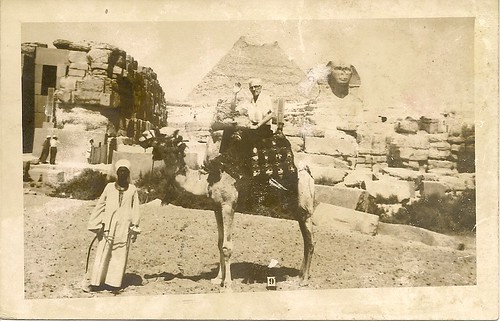
To read the earlier E-Sylum articles, see:
WAYNE'S NUMISMATIC DIARY: JANUARY 26, 2014
(www.coinbooks.org/esylum_v17n04a15.html)
QUIZ ANSWER: WHO IS THE MYSTERY NUMISMATIST?
(www.coinbooks.org/esylum_v13n19a07.html)
Replacement Victoria Cross Medals Mr K Ooi MA writes:
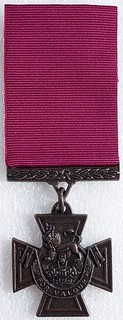 I have just seen Darryl Atchison's piece at the end of which you ask if any official replacement VCs have crossed the auction block. I know of at least one, that to Thomas Byrne, 21st Lancers. This was offered for sale by Spink in London in the Nineties. As the price for official replacements are significantly lower than that for originals I have been trying to buy one for the last 12 years but have not seen any on the market.
I have just seen Darryl Atchison's piece at the end of which you ask if any official replacement VCs have crossed the auction block. I know of at least one, that to Thomas Byrne, 21st Lancers. This was offered for sale by Spink in London in the Nineties. As the price for official replacements are significantly lower than that for originals I have been trying to buy one for the last 12 years but have not seen any on the market.
Darryl says in the article that he does not know how the official replacement VCs are marked to distinguish them from the originals. In the case of official replacement VCs the edge of the lower arm of the cross is inscribed "Duplicate".
To read the earlier E-Sylum articles, see:
QUERY: REPLACEMENT VICTORIA CROSS MEDALS
(www.coinbooks.org/esylum_v13n45a18.html)
OFFICIAL REPLACEMENT VICTORIA CROSS MEDALS
(www.coinbooks.org/esylum_v13n46a09.html)
More on Chinese Lai-See or Ya Sui Money Reader Li/Tiesheng of Hohhot, Inner Mongolia, China writes:
There are something I would like to add.
1 Lai See is a Cantonese name( pronunciation ) which used in Hongkong, but in mainland China, by standard Madarin, it should be prounouced as Ya Sui (压岁)。
2 Ya(压)means "press down". "kick out". Sui(岁) here used as a homonym of Sui(祟). which is an small devil annoying the children. So Ya Sui money is originally used as the gift money by the elders to the youngsters, helping them to get rid of the devil. Of course, Sui(岁) is also meaning a year/or the end of a year.
3 This custom is very wide spread in whole China. But the money need not to be crisp new. Good-as new and well-kept banknotes are all right. It is something like the Santa Claus brought the gifts to children at Christmas day.
To read the earlier E-Sylum article, see: CHINESE LAI-SEE MONEY (www.coinbooks.org/esylum_v17n04a26.html)
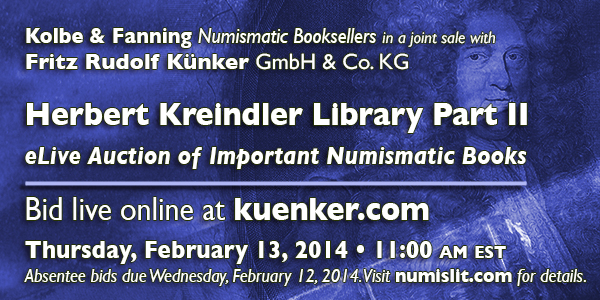
MAN CAPTURES UNICORN: 1974-D ALUMINUM CENT

The first known example of a 1974-D aluminum cent will go on the auction block during the Central States Numismatic Society convention April 23-27 in Schaumburg, Ill., in a Signature Sale conducted by Heritage Auctions.
“This is an amazing discovery and we estimate the 1974-D aluminum cent will bring a quarter million dollars or more,” said Todd Imhof, Heritage Auctions executive vice president.
Long rumored to exist in private hands, the example going on sale traces back to Harry Edmond Lawrence, deputy superintendent of the Denver Mint.
The rarity passed to his son after he died in 1980 and Heritage relates that he did not know what he had.
Last September Randy Lawrence arranged to sell the coin and others he had inherited to Michael McConnell of La Jolla Coin Shop in California.
Heritage quotes McConnell as saying, “I first thought the 1974-D cent was struck on a planchet intended for a foreign country, and I purchased it as such.”
He called Armen Vartian, the legal counsel of the Professional Numismatists Guild, who has his office in Manhattan Beach, Calif. Vartian called error specialist Fred Weinberg of Encino.
The coin was submitted to the Professional Coin Grading Service by McConnell as arranged by Vartian.
PCGS calls the pattern genuine and graded it MS-63.
“There’s been speculation about the existence of 1974-D aluminum cents for decades. Now, there’s a confirmed coin, and a portion of the proceeds from its sale will be used by the sellers to help the homeless,” Imhof said.
Randy Lawrence said the aluminum cent and other coins he inherited had been kept in a plastic sandwich bag by his father.
“I didn’t know what the coins were. My father sometimes received coins as gifts during his government service, and I kept them in that same plastic bag in a desk drawer for 33 years,” said Randy Lawrence.
Aluminum cents were mass produced in 1974 on the expectation that Congress would approve the composition for use in the cent. Examples were given out to elected officials as they deliberated. Congress did not approve the composition and the Mint requested the patterns be returned. Most were, but an estimate five to 14 were not.
According to a Feb. 21, 1976 story in Numismatic News, the United States government closed its investigation of any missing 1974 aluminum cents by February 1976 having found, in the government’s own words “no evidence of criminal intent” by anyone possessing any of the coins.
To read the complete article, see: Heritage Schedules Aluminum Cent Sale (numismaster.com/ta/numis/Article.jsp?ad=article&ArticleId=27601&et_mid=658552&rid=238176646)
MISSOURI CABINET OF U.S. HALF CENTS BRINGS $18 MILLION

The face value was one-half cent, but a 1794 Liberty Cap variety sold at auction Jan. 26 for $1,150,000. And an 1811 half cent brought $1,121,250.
The coins were part of the Missouri Cabinet Collection, which contained every variety of half cent struck from 1793-1857.
The 228 coins brought a total $18,259,269, which includes the 15 percent buyer’s fees, at the Ira & Larry Goldberg Coins & Collectibles auction held at the Luxe Sunset Boulevard Hotel in Los Angeles.
“Fifty years from now, people will remember that sale,” said Larry Goldberg following the auction. “We had over 100 people at the auction and some were yelling out prices, which you usually don’t see in a copper sale.”
The sale took six and one-half hours, and although the coins brought plenty of competition, it was a congenial group of mostly collectors bidding.
“It was spirited, friendly competition,” Goldberg said.
“Everybody came out of there smiling,” said Bob Grellman, who cataloged the collection with Chris McCawley. The auction was a joint effort with McCawley & Grellman Auctions and the Goldbergs.
The finest known specimen of the classic 1794 High Relief type half cent went to Brent Pogue of Texas, who purchased the coin for the Pogue family collection.
When it comes to half cents, the Missouri Cabinet Collection is the best of the best.
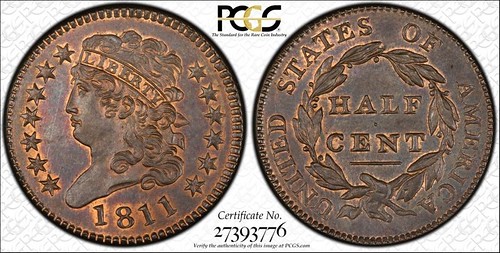
But then again, it took more than 40 years and the efforts of several noted numismatists to amass such a collection. At the heart of it is a collaboration between R. “Tett” Tettenhorst and the Eric P. Newman Numismatic Education Society (EPNNES).
The Missouri Cabinet Collection includes Tettenhorst’s half cent collection and the half cent collection of Eric P. Newman, which includes cents from the collection of Col. Edward H.R. Green, which Newman had donated to EPNNES.
Tettenhorst had custody of all the Missouri Cabinet Collection half cents and managed the continued improvements to its collection, Grellman said.
Tettenhorst and EPNNES were pleased with the auction results, Grellman said.
And for good reason. The catalog estimates put the collection value at about $7 million, with pre-auction estimates of the final hammer price at about $10 million. With a final total of $18,259,269, the auction was beyond successful.
To read the complete article, see: 2 Half Cents Top $1 Million (numismaster.com/ta/numis/Article.jsp?ad=article&ArticleId=27602&et_mid=658552&rid=238176646)
BILL ECKBERG'S MISSOURI CABINET DIARY
Part I (January 24, 2014, 9:47 PM)
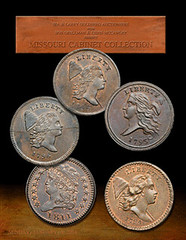 I’m on my way to the Missouri Cabinet Sale. It is the sale of what is by far the greatest half cent collection that has ever been and almost certainly ever will be formed. I’m a scientist, so I never say things in absolute terms; this is as close as I can get. It’s a huge event for a half cent guy, like me - the sale of a collection formed by R. Tettenhorst (not his real name, and I’m not going to reveal it here) and Eric Newman, numismatic polymath and 102-year-old collector par excellence
I’m on my way to the Missouri Cabinet Sale. It is the sale of what is by far the greatest half cent collection that has ever been and almost certainly ever will be formed. I’m a scientist, so I never say things in absolute terms; this is as close as I can get. It’s a huge event for a half cent guy, like me - the sale of a collection formed by R. Tettenhorst (not his real name, and I’m not going to reveal it here) and Eric Newman, numismatic polymath and 102-year-old collector par excellence
Part III (January 26, 2014, 2:17 AM)
The three of us drive over to the Heritage Galleries. There isn’t much early copper to see, so I look at small cents, including two red proof 1864-L examples and a full red 1955/1955. But none of these are for me, so it’s off to the hotel where the reception will be. Have a seat in the lounge and touch base with Susan at home.
Promptly at 6 the reception opens.
I finally meet Lyle Engleson, the Goldbergs’ superb photographer. He proves to be the same, nice guy he was by email when we were working on the grading guide. There are a bunch of people that have rarely been seen at EAC in recent years: Bland, Bobbie, Hanson, Coleman, etc. They’ve come for the big show, and I’m sure they won’t be disappointed. I chat at length with Tett's wife, Marilyn and with Pat Husak.
Part IV (January 26, 2014, 10:27 AM)
People were at the party last night whom I haven’t seen more than once or twice in the 24 years I’ve been an EAC’er. There was even one owner of a major collection whom I’d never seen. While to me, collecting is a social process, there are those who want their privacy, and we all respect that. The Man of the Hour has bridged the two by using a pseudonym in numismatics, which has allowed him to be completely outgoing and open with the rest of us, while still maintaining some privacy.
Tett was self-effacing as always, Marilyn was charming as always, and everyone else seemed to be in a great mood. The food was plentiful as were the beer, wine and soft drinks, but I made it a point not to take seconds of anything other than the very nice mini-Kobe beef tacos, of which I did have two. The reception was in a courtyard, and there were several ornamental gas heaters that I thought were unnecessary. There also were two different posters that everyone was asked to sign. One was to be sold as the final lot in the MoCab sale with proceeds to EAC. The other as a gift to a collector whose name I won’t divulge, as he may not know this is being done.
Part V (January 26, 2014, 11:40 PM)
We arrive at the Luxe Sunset Boulevard Hotel for the auction about 9:30 and find the room already crowded. Every seat behind the first two rows seems to be taken, so we get seats in the second row, center. The bad news is that we won’t know who’s bidding. The good news is that if we bid, at least Ira will see us. I chat with friends, try to suss out who’s after what (generally failing at that), and get ready for what I’ve come to call “The Bloodletting.” I am bidder #162, not that you will hear a lot about that again.
The first few lots go pretty much as expected, though I think the gorgeous 1793 C1 is a bargain to the buyer at $330K. I’ve guessed that lot 6, the PCGS 66 C4 COULD top $1M. It hammers at $800k, or 92% of that, with the juice. The 1794s generally go for good, but not spectacular money, though the C7 does hammer at $1M - the first half cent ever to sell (publicly, at least) for over $1M. The C9 goes for more than 4x the estimate, but the UNC 1795 C-5 with the planchet flaw hammers for less than half the estimate. It’s clear at this point that there is a pattern developing. The big spenders are set registry folks, which is what most of us expected, unfortunately.
The 1796 no-pole is another lot that many of us thought might fetch $1M, but it hammers at $775K, only marginally above estimate. The 1797 C2 sells for a strong $350K, about 7x estimate, and the finest-known low-head fetches $150K, or 5x estimate. Tett’s favorite coin (and my favorite of his collection), the low head struck over a 1798 large cent in 1800, brings a strong $77,500.
Then it gets interesting. The RB 1800, a coin VERY much like the one Susan gave me for a wedding present and which now graces a Nebraska collection, goes for a whopping $40K! But a bigger shocker is that a RB 1803 C3 (R1!) brings a $250K hammer!!! A lot of us are looking around going “huh?” Draped Bust variety collecting is alive and well, as most lots go well over their estimates, but not obscenely so, though a PCGS 66 C8 Spiked Chin hammers for nearly 6x the estimate. The red C13 brings a strong $65K, and we break for a very nice lunch.
It gets really weird when we come back. The RB 1805 C4 seems to be the harbinger, bringing nearly $100K on a $20K estimate. The very common, even in UNC, 1806 C1 in 66RB brings an astounding $120K. A typical LDS 1807 with nice color surprised me at $62.5K, whereas the by far finest known 1808 C1 hammers at $160K, just above the estimate. The 1808 C2 in UNC goes for $420K.
By now, people are starting to make funny faces and look around. R1 varieties of 1809 all hammer for several tens of thousands of dollars. A very nice 1810 hammers for $95K against a $12.5K estimate. Then comes the prooflike RB 1811 C1. It becomes the second million-dollar coin, hammering at $975K or $1.21M with the juice. Prices continue to be strong through the rest of the Classic Heads, but mostly for the pop tops. A hoard coin, 1828 C3 goes for $22K! Can you say Set Registry collector?
The sale of 230 lots has taken just about 6 1/2 hours. A lot of it went slowly, because the book bids were low, so the coins started at prices far less than they eventually brought. Many of us, not least myself, came because we wanted to honor Tett, a gentleman of the first order who has been a wonderful mentor to so many of us. Every time I have ever asked him for information, he gave more than I asked. Years ago, I asked him for some information about his error set, and he sent me many pages of handwritten material, describing every significant error coin he had. That led to two articles in P-W, and for that and MANY other kindnesses, I am forever grateful to him and proud that I was able to score a couple of the error coins about what I wrote.
But it’s bittersweet seeing these coins sold. There is no chance that many of the new owners will share them with the rest of EAC - if they are even members - the way Tett always has. We will miss the coins, but I know Tett will continue to come to EAC shows to spend the time with his friends. And he has MANY friends.
As many of you know, this collection was a collaboration between Tett and Eric Newman. Most, if not all, of Eric’s coins had not sold publicly for a century. That and their freshness may account for some of the huge prices.

SHOULD HISTORICAL MEDALS BE ENCAPSULATED?
Research on medals, compared to research on coins, is in its infancy. The grading companies neither have, nor is it possible for them to have, the level of expertise across the board for historical medals that they can offer for coins.
In order to meet the same standards used in grading and authenticating coins, the duty of the grading companies to competently and accurately encapsulate medals requires them to have expertise in authenticating and grading well over a thousand different medals of different designs, compositions, and manufacturing processes, manufactured over a period of nearly 500 years. For now they can accomplish this using only a few scattered references (Betts is over 100 years old and seriously outdated), and with no grading standards in existence. Only one word comes to mind: “Impossible”.
With historical medals, there are no published grading standards and no grading sets, so it is impossible for the grading services to meet the same grading standards they use for coins As said earlier, between all of the categories of historical medals they include in their services, there are thousands of designs and even more varieties. With no standards, limited references, and minimal experience and expertise with an overwhelming number of different types and designs of medals spanning many centuries, it is not possible for them to meet the same standards for grading historical medals that they use for coins.
My solemn advice to medal collectors is to free your “graded” medals from their slabs so that you can “feel” the history. Save your money on third party authentication and grading. And, when deciding what to bid, or whether to buy, ignore everything written on the plastic.
In the issue editor John W. Adams writes:
This issue features a landmark article by Tony Lopez. The piece provides fascinating insights into Tony’s authentication techniques, but its special importance derives from its discussion of the role of grading services in the collecting of historical medals. The author firmly rejects the idea of encapsulation on general principles, with which most readers would agree.
The more courageous point he makes is that, unlike the situation with coins, the grading services do not have the expertise either to grade or to authenticate. He makes his case with a series of examples that NGC and PCGS would find difficult to refute. Given that medals represent virgin territory for the grading services, it will be difficult to keep them out unless more collectors emulate Tony’s example of trashing the plastic.
Tony adds:
You will see in the next issue of the MCA Advisory the record-breaking amount of correspondence and discussion that has followed the article. I am pleased the subject matter struck an important chord in the hobby. Hopefully something positive will come of it.
To learn more about the Medal Collectors of America, see: www.medalcollectors.org
URSULA KAMPMANN VISITS THE ANS
Parva ne Pereant – so the small may not perish! I cannot conceive of a better motto for a society that is exclusively devoted to preserving the smallest historical objects there are, to coins and other numismatic artifacts. The American Numismatic Society has taken this motto to heart and has been conducting research on numismatics and the history of economics for over 150 years.
In the ANS foyer, there are a number of show cases which often display newly acquired objects. At the moment, they show a part of Vladimir and Elvira Clain-Stefanelli’s archive as well as selected items from the Huntington Collection. CoinsWeekly also reported in detail about what happened to the Huntington Collection: the collection, which had been on permanent loan at the ANS nearly ever since its foundation, had been auctioned off by its owner, the Hispanic Society of America, due to financial difficulties. With the help of generous donors, however, the ANS succeeded in buying back a large part of the collection.
Speaking of which – the importance of sponsors simply cannot be stressed enough! Without their help the ANS could not achieve nearly as much as it does. Unlike many other museums and research institutes, the society is barely subsidised by the government. Wages, publications, projects and other various expenses have to be covered by third-party funds. Fortunately, the responsible curators have truly mastered this discipline. Most European museums would be amazed by the highly sophisticated strategies for addressing different target groups. Donations of important collections are nothing out of the ordinary. Currently, one of the show cases displays Alan Helms’ collection of African iron money which he gave away to the ANS in 2012.
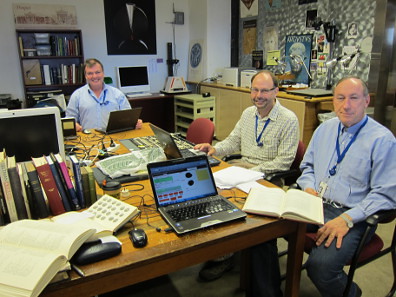
Kenneth Sheedy, Damian Gore and Gil Davis are
registering the ANS coins for a corpus of early Athenian coins
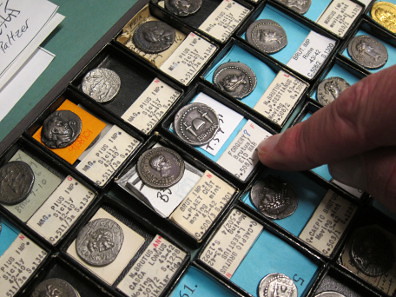
Brutus - and the coins of the Roman Republic
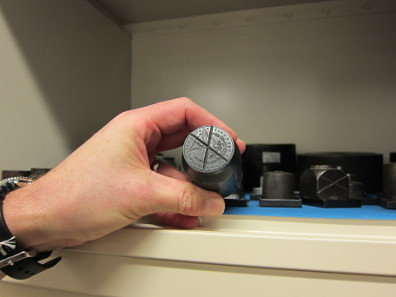
U.S. Mint Die

ANS library
Even though today all publications held in the ANS library can be retrieved via the DONUM database, the old index card catalogue still remains an important tool. After all, since the society’s foundation new acquisitions have been catalogued and tagged here with key words by no less than 21 librarians.
The ANS has held its place among the most important numismatic associations worldwide for more than 150 years now. And chances are that it will remain there for at least another 150 years.
To read the complete article, see: Parva ne Pereant – A visit to the ANS (www.coinsweekly.com/en/News/4?&id=2573)
BYRON WESTON AND CONTEMPORARY COUNTERFEIT HALFPENCE
 I started collecting as most coin collectors of today, with Lincoln Cents, when I purchased a partially filled album from a classmate in the 7th grade. I never thought then that I would become as involved in the hobby of Numismatics as I have become today. To make a long story short, and as most collectors do, I eventually specialized into one area. The area that I chose was Colonial and Confederation era coinages; what circulated before we became what is now the United States.
I started collecting as most coin collectors of today, with Lincoln Cents, when I purchased a partially filled album from a classmate in the 7th grade. I never thought then that I would become as involved in the hobby of Numismatics as I have become today. To make a long story short, and as most collectors do, I eventually specialized into one area. The area that I chose was Colonial and Confederation era coinages; what circulated before we became what is now the United States.
Although I still collect within this subcategory within the larger realm of American coinages I specialized even further into an even smaller category; Contemporary Counterfeit Halfpence. Over the last decade and a half I have authored or co-authored a dozen or more research papers about this largely forgotten and ignored area of numismatics.
One of my first papers that I authored myself took up an entire issue of The Colonial Newsletter, and was only the third single subject issue in the publications history. I’d like to think that all that research and writing had something to do with the increased popularity of counterfeit halfpence. Apparently it has as coins that I purchased for one or two dollars in the early 1990s are now selling in the $200 to $300 range, with scarcer coins selling well into the thousands. Before this they were largely ignored by collectors and numismatics as whole for well over 200 years.
Interestingly, if you were a person living in what is now the United States say, shortly before the revolution, counterfeit halfpence is most likely what you would have had to spend. We were still British then and the Crown did not produce enough small change for use at home let alone within its colonies, and so people simply made their own. Hardly a ship from England arrived with casks labeled “hardware” that actually contained counterfeit halfpence!
Coins have been very good to me – not all that unlike baseball and football has been for the pros, and I’ve come a long way since my humble beginnings. Not only has my research been footnoted in others work, in books, and on websites, but pictures of my coins have been used for illustrations. I’ve also managed to build a premier reference collection of contemporary counterfeit halfpence – before prices skyrocketed – so I guess you could say there was a method to my madness. But I didn’t know or even imagine that ever happening when I was in the 7th grade.
I asked Byron for some coin images to illustrate this article, and he forwarded pictures of two of his personal favorites. Nice! -Editor

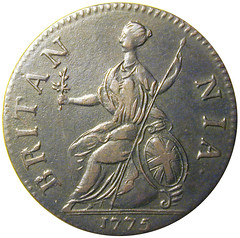
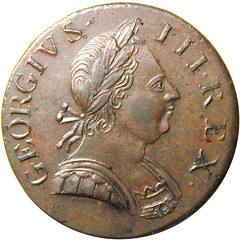
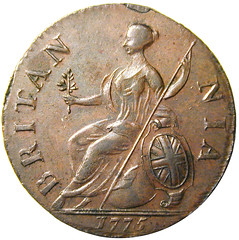
To read the complete article, see: Coin Collecting with Byron Weston (itshr.psu.edu/2014/01/16/january-2014-its-hr-newsletter/)
THE BOOK BAZARRE
COIN WORLD ARTICLE ON JOHN BURNS
Following the news of Mr. Burns’ death, McBride said he and Wayne Homren, editor of The E-Sylum, the online publication of the Numismatic Bibliomania Society, had discussed what needed to be done, as they considered themselves Mr. Burns’ oldest friends.
McBride said arrangements are being made for cremation and the sale of Mr. Burns’ book inventory to pay off any debts.
“I’ve known him since 1984 and he was a good friend,” McBride said.
He said he plans to return to Florida soon and make arrangements to claim Mr. Burns’ vehicle and the inventory from his table that FUN officials have placed in storage.
Cindy Wibker, FUN’s convention coordinator, confirmed that FUN has Mr. Burns’ books in storage and personal items that were at his table.
McBride said PAN officials are planning on setting up a John Burns Memorial Fund to support numismatic research.
“He would tell people at shows when they asked him what he had to sell, that he sold knowledge,” McBride said.
We are heartened by the steady response to the John H. Burns Memorial Fund. Pat reports that donations have been coming via the mail and the PAN web site. To donate to the fund or get more information about the PAN show, visit the site at www.pancoins.org .
One of the concepts we've discussed for use of the funds raised is a "John Burns Coin Show Reference Library", a small but useful collection of reference books that coin show attendees can use. A volunteer or paid Young Numismatist could serve as librarian, helping collectors and the general public look up their coins. We would of course refer people to the show's supply dealer to purchase copies of the books if they find them useful. So as not to compete, the library may not always have the latest editions of all books on hand. The library would be a way to keep John's presence at shows and continue his mission of numismatic education. Please let us know what you think. -Editor
To read the complete article, see: Numismatic literature dealer John Burns dies at FUN show (www.coinworld.com/articles/numismatic-literature-dealer-john-burns-dies)
To read the earlier E-Sylum article, see: THE JOHN H. BURNS MEMORIAL FUND (www.coinbooks.org/esylum_v17n04a02.html)
KRALJEVICH REMEMBERS JOHN BURNS
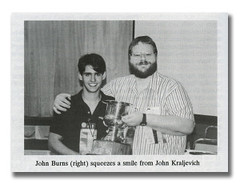 Josiah Wedgwood’s gran. That’s as much as the emcee, Donn Pearlman, got out before Big John rang in. “Charles Darwin,” he intoned in his deepest matinee idol voice, the smirk of self-satisfaction expanding across his bewhiskered face with each successive syllable. Most folks in the room didn’t know who Josiah Wedgwood was, let alone who his grandson was. All I could wonder, beyond how John knew the answer to the question before it even got asked, was what other knowledge was kicking around inside that too-big-for-most-hats head of his.
Josiah Wedgwood’s gran. That’s as much as the emcee, Donn Pearlman, got out before Big John rang in. “Charles Darwin,” he intoned in his deepest matinee idol voice, the smirk of self-satisfaction expanding across his bewhiskered face with each successive syllable. Most folks in the room didn’t know who Josiah Wedgwood was, let alone who his grandson was. All I could wonder, beyond how John knew the answer to the question before it even got asked, was what other knowledge was kicking around inside that too-big-for-most-hats head of his.
After being crushed with disappointment with a second-place finish in 1993, John Burns and I won the ANA’s World Series of Numismatics in 1994. John felt like he’d let me down the year before, but his sourness in the hands of defeat turned to the highest high I’d ever seen him on when we won. The victory meant, to him, all the reading, all the work had been worth it, that his previously unrecognized brilliance had finally gotten a moment to shine.
Of course, all his friends already knew he was brilliant, as did most casual observers who engaged him in conversation. He knew more about coins than most full time dealers, able to talk turkey on VAMs or novodels or sestertii. He could hold his own in any discussion of history, sports, politics, movies, music (from classical to heavy metal), food and drink, cars, guns, geography, or a million other topics. About the only topic John lacked a mastery of was entrepreneurship. He could never quite monetize his brilliance, much to his frustration. He once mused to me that “intelligence is not a skill.” He was always happy to rail against the “slab boys” who could buy and sell his net worth a dozen times in a summer afternoon with no more knowledge than what might be found in a typical Grey Sheet. More than once I encouraged him to try out trading, under the guise of joining them if beating them isn’t in the cards. But John had no love for trading, and one thing about John was that he only did what he loved.
John loved mastering knowledge, both foundational and trivial, and that meant John loved books. He loved their weight and tactile sensations (even if he did spit curses at every loading dock he ever saw). He loved how they were gateways to things he’d never own and places he’d never visit. He loved their ability to serve as an equalizer, as a repository of that most final of weapons, information. Of course, John also loved a big steak, a nice whiskey, and a cold beer. He loved just about everything about a woman that a woman had to offer, and a wink or a hug could turn him into a massive pile of sweaty smiles and blushing. John loved his dad and adored his friends. He loved his friends’ friends and his friends’ families. He loved chatting, at his booth at a show or on the phone.
It's no wonder John did so many coin shows. The people he found there were his kind of folks: clever and funny, maybe a little awkward or odd, generally very smart and very sincere. He was forever inviting himself into dinner groups where he thought good convivial conversation could be had. John identified with a line I’d heard from a mutual friend of ours years ago, that most coin folks were misfits and loners. Of course, though John was an oddball and spent most of his time alone, he was really neither a misfit nor a loner. He loved being with his gang, and he fit in just perfectly in the world of numismatics.
To read the complete article, see: IN MEMORY OF A MENSCH: JOHN H. BURNS (www.jkamericana.com/kraljeblog/?p=87)
To read the earlier E-Sylum article, see: THE JOHN H. BURNS MEMORIAL FUND (www.coinbooks.org/esylum_v17n04a02.html)
Pete Smith writes:
I received the Coin World issue with the tribute ad to John H. Burns. You indicated that the list would include two false names. I have met everyone on the list except two.
Although I am an old geezer, I am not old enough to have met Josiah Wedgewood's Grandson, who was born on the same day as Abraham Lincoln.
Then there is Nick Economopolis. At first I thought this referred to a North Carolina girl's basketball coach. However, I was confused with Nick Economopoulis.
If there is another false name on the list, then I am remembering meeting someone I didn't meet. That sort of stuff happens when you are an old geezer.
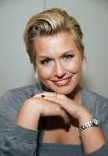 Kraljevich told Pete to "Go Google 'Emme' and report back. Turn SafeSearch off."
I did and I didn't, and learned from WikiPedia that "Melissa Aronson, better known as Emme (born 1963), is a plus-size model, and is largely recognized as the leading model in the profession, as well as its highest earner."
-Editor
Kraljevich told Pete to "Go Google 'Emme' and report back. Turn SafeSearch off."
I did and I didn't, and learned from WikiPedia that "Melissa Aronson, better known as Emme (born 1963), is a plus-size model, and is largely recognized as the leading model in the profession, as well as its highest earner."
-Editor
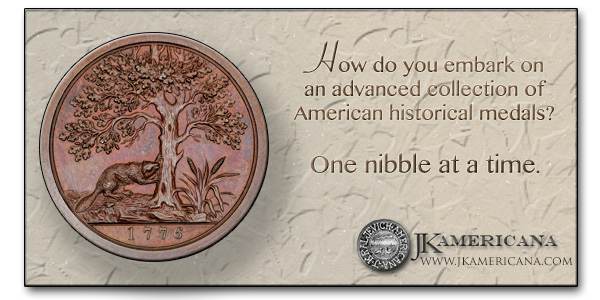
THE BANK OF ENGLAND £1M AND £100M BANK NOTES
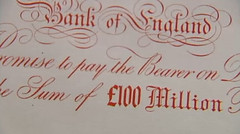 For the first time the Bank of England allows the £1m and £100m bank notes, which underpin the Scottish banking system, to be filmed. Economics Editor Faisal Islam gets his hands on them.
For the first time the Bank of England allows the £1m and £100m bank notes, which underpin the Scottish banking system, to be filmed. Economics Editor Faisal Islam gets his hands on them.
The £100m banknote is generally held by the Scottish banks in order to back-up banknotes that are issued in Scotland.
The notes are a physical manifestation of the relationship between the Bank of England and the Scottish banking system, something that was discussed on Wednesday by the Governor of the Bank of England Mark Carney.
To read the complete article, see: Got change for £100m? - video (www.channel4.com/news/scotland-bank-of-england-independence-100m-banknote-video)
THE SCOUT ASSOCIATION’S SILVER CROSS
 A rare silver medal for gallantry presented to a Wroxham boy scout by Lord Baden-Powell is to go under the hammer at a Norfolk auction house.
A rare silver medal for gallantry presented to a Wroxham boy scout by Lord Baden-Powell is to go under the hammer at a Norfolk auction house.
The Scout Association’s Silver Cross was presented to patrol leader Jack Howes, of the 1st Wroxham Scout Group, in August 1928 for ‘Gallant Attempt to Rescue a Young Man from Drowning in the River Bure’.
The medal is set to be auctioned on Tuesday at Keys Fine Art Auctioneers in Aylsham and it is estimated to be worth between £500 and £600.
It was presented to Jack Howes by the founder of the Scout movement, who was said to be a regular visitor to Wroxham and enjoy sailing on Wroxham Broad with his friend Colonel Charles, after whom Charles Close in the village is named.
An article about 15-year-old Jack’s rescue attempt, published in the Norwich Mercury on August 4 1928, told of how the then coroner, Mr Coroner Barnard, praised Jack, also known as John Henry, of Platten’s Yard, Lower Wroxham, for attempting to rescue 20-year-old Edgar William Palmer, a butcher’s assistant from Foulsham.
The two had been swimming in the River Bure at the Cane Meadow. They swam across the river together but Edgar got into difficulties as they swam back.
Jack had tried to swim with him back to the bank, and Jack’s brother also fetched a boat to help but they were unable to save Edgar despite their best efforts.
The newspaper reported that ‘the Coroner recorded a verdict of accidental drowning, through having got into difficulties whilst bathing’.
To read the complete article, see:
Rare medal presented to Wroxham boy scout by Lord Baden-Powell to be auctioned
(www.edp24.co.uk/news/rare_medal_presented
_to_wroxham_boy_scout_by_lord_baden_powell
_to_be_auctioned_1_3260935)
MAKING THE CODE TALKERS CONGRESSIONAL MEDALS
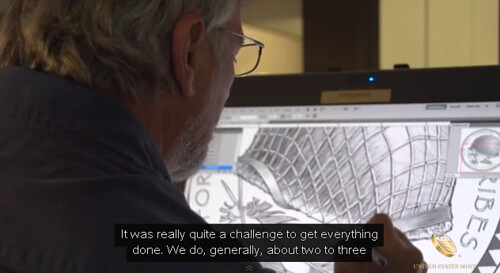
Code Talkers medal sculptor Don Everhart
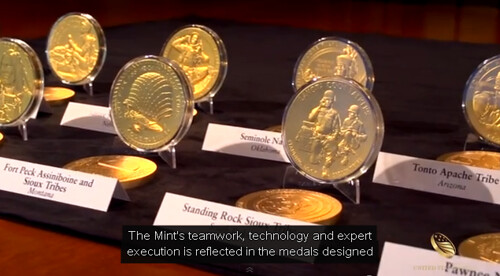
Finished Code Talkers medals
To view the complete video, see: Making The Code Talkers Congressional Medals (www.youtube.com/watch?v=F9OOrZrtl7w)
THE BOOK BAZARRE
ELECTRONIC PUBLISHING IN NUMISMATICS
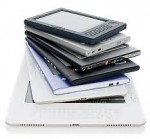 Since my response to Dennis Tucker, Publisher of Whitman Publishing LLC, I have received a mix of private email notes about one phrase: calling physical books ‘Dead Tree Editions.” In the first two hours after the post appeared, I received more than two-dozen email notes running slightly in favor of physical books. As of Wednesday afternoon, the score was 17-15 in favor of real paper.
Since my response to Dennis Tucker, Publisher of Whitman Publishing LLC, I have received a mix of private email notes about one phrase: calling physical books ‘Dead Tree Editions.” In the first two hours after the post appeared, I received more than two-dozen email notes running slightly in favor of physical books. As of Wednesday afternoon, the score was 17-15 in favor of real paper.
I do not know the demographics of those who did not volunteer the information, but based on the comments like, “I have been collecting for umpteen years…” or “I was a teenager when clad coins were just beginning…” it does not take much to get a general idea of demographics.
Of the 17 who responded that they prefer paper books over e-book, I am guessing that 12 are like me, members of the AARP demographic (50 and over).
I have no problems with people opting for paper books over electronic edition. My complaint is not with the preference but the availability of e-books that will allow me and everyone else to choose. I understand the need for choice because neither Whitman nor I will convince everyone to only read e-books.
However, if you look at the demographics of the ANA and its future, the next generation that are its future members, the so-called Generation X people, is the first generation of significant technology adapters and e-book readers. Gen X’ers are the first big wave of technology adapters who know of a connected world and have a vague memory of a world before Al Gore invented the Internet.
Right behind Generation X are the Millennials who grew up with the explosion of the Internet and probably have never read a newspaper cover-to-cover. While hobby publishers may have some time adjusting with Generation X, they will lose completely to the Millennials if they do not adapt.
Whitman is not the only publisher that needs to better examine its use of technology. Krause Publications is not much better. Where Whitman lacks in vision, Krause lacks in execution. Rather than embrace electronic publishing that is friendly to e-readers, Krause and F+W Media, its parent, is holding onto the old-style by offering its products using Portable Document Format (PDF) rather than using formats that are friendlier to e-readers.
I have purchased the Krause Standard Catalogues and the various antique guides from F+W on CD or DVD because that is what is available. I use them as part of my hobby and my new professional life in the collectibles business, but I wish I had real e-reader formats so that I can use the tools to bookmark and make annotations. Even the venerable Numismatic News has stuck its publishing toe in the e-publishing waters by making one edition electronic. However, instead of embracing the newsstand formats that would be friendly to an iPad or Kindle e-reader, they are mailing PDF layouts of this publication.
In the meantime, the American Numismatic Association is producing an e-reader friendly version of The Numismatist that is far easier to read than the PDF edition of Numismatic News emailed monthly. Since The Numismatist reader app works well, I stopped receiving the paper edition of The Numismatist opting for a Basic membership and to read the journal electronically. I do not miss the “Dead Tree Edition.”
To read the complete article, see: What e-publishing means for the hobby (coinsblog.ws/2014/01/what-e-publishing-means-for-the-hobby.html#sthash.vVIZR1D7.dpbs)
1947 ACADEMY AWARD MEDAL AUCTIONED
 An extremely rare Academy Award medal for still photography, presented in 1947 to Earnest Bachrach sold for $45,049 on Wednesday, according to Amherst, NH-based auction house RR Auction.
An extremely rare Academy Award medal for still photography, presented in 1947 to Earnest Bachrach sold for $45,049 on Wednesday, according to Amherst, NH-based auction house RR Auction.
A revered photographer of Hollywood’s ‘Golden Age,’ Bachrach was given the medal by the Academy of Motion Picture Arts & Sciences for his work on Crossfire and The Farmer’s Daughter.
He was especially well-known for his portrait studies of great actors and actress, including a series of color shots of Marilyn Monroe; also admired for his versatility, Bachrach's production work on King Kong is noted for the various effect shots and composites he produced both for continuity and the promotional campaign.
Only two other medals such as this are known to exist, one awarded to Merritt Sibbald in 1941 and the other to Scotty Welbourne in 1942.
To read the complete article, see: Rare Academy Award for Photography sold for 45k by NH-based auction house RR Auction (artdaily.com/news/67786/Rare-Academy-Award-for-Photography-sold-for-45k-by-NH-based-auction-house-RR-Auction#.Uu5ZWvmcJRQ)
ERIC P. NEWMAN COLLECTION PART III SALE RESULTS
This enigmatic and possibly unique coin, graded AU58 by NGC, is a very rare denomination, and is listed as "rare" in those few references where it can be found at all. Although this is a large, high-relief coin, the ornate design elements are fully and delicately struck, with just the slightest wear to show that it did briefly fulfill its commercial purpose.
"The Eric P. Newman Collection is without a doubt the finest on Earth, and it is thrilling to see collectors respond when treasures like the 14 ducat appear," said Cristiano Bierrenbach, Executive Vice President of International Numismatics at Heritage. "This collection is highly nuanced and complex in its approach, and bidders understand why it's important to add these selections now."
A second possibly unique coin from the 17th century, a 1674 double taler from Emden, also reached the six figure level when it sold for $111,625. The obverse of the coin, graded MS66 by NGC, depicts the city of Emden from the point of view of its harbor, still an important port in Northwestern Germany today. The extremely rare single Taler of this design is never found in Mint State grades, let alone the Premium Gem level of this multiple Taler.
Although struck in the 18th century, a Russian 1729 gold Ducat, was another star of this sale as it crossed the auction block for $205,625, taking second honors. Graded AU50 by NGC, 15 bidders competed for the exceptional example of an exceedingly rare one-year type, which is also from the rarer of the two major varieties of the issue.
Selections from the Eric P. Newman Collection of World Coins will continue to be offered in five online monthly events starting Feb. 27, 2014 with the last auction event concluding the last week of July 2014. These will include more than 1,500 additional coins from the collection separated by geographical region from Central and Eastern Europe to the British Isles to the Americas, Africa, Asia and Oceania.
Items being sold are from the extensive collection of Eric P. Newman Numismatic Education Society (a Missouri not-for-profit corporation) and have been assembled over a period of 90 years. Proceeds of the sale of all items will be used exclusively for supplementing the Society's museum operations and scholarly numismatic research efforts and for the benefit of other not-for-profit institutions selected by Eric P. Newman Numismatic Education Society for public purposes.
For more information, visit:
www.ha.com
These cambist postcard discussions in The E-Sylum are starting to get me enthused again about the topic. Here are a few comments specifically about cards of the United States.
Hugo Semmler produced U.S. cards using four different embossing dies. (Numerous printing varieties occur with each die, as well, most noticeably the language of the inscriptions.)
What appears to be the earliest die shows the reverse of a U. S. trade dollar in the upper left corner. It even has the S mint mark.
Early on, the dollar image on the die was changed to the Morgan reverse, without a mint mark. The rest of the die is unchanged.
The whole die was then remade with the same images. Notice that the word DOLLAR is now tiddlywinked by the half dollar so that only DOLLA shows. Ditto for the $20 – the three lowest stars on the left are similarly “eclipsed.” (This is the die used to make Frank Drascovic’s card; his version has English printing, mine has French, but they come from the same embossing die.)
Finally, another die remake occurred with the lowest star on the left of the $20 reappearing.
Further changes to the U. S. cards were made by subsequent publishers. By 1930 there were two different U. S. cards, one for gold coins and one for silver and minor coins.
I noticed on Semmler die 4 is the addition of an image of the gold dollar (with 1853 date on the obverse) at lower right. Artistic license?
There are many back varieties to the cambist cards. They come divided and undivided, tête-bêche and straight up -- in German, French, Italian, English, Hungarian, Dutch, Spanish, Czech, Afrikaans, Russian, Portuguese, Romanian, some I don't recognize (Karta korespondencnyjna, Korespondencni listek, Correspondenzkarte)and multilingual. The backs can serve as clues to classifying the cards, which is quite a job. Takers?
Below is the two-card set. The maker is Walter Erhard of Waiblingen-Stuttgart. Erhard took over from Max Heimbrecht in the mid 1920s.
To read the earlier E-Sylum article, see:
MORE ON NUMISMATIC POSTCARDS
(www.coinbooks.org/esylum_v17n04a19.html)
The itinerary for the ticket was found to have been changed more than 300 times within a year, and the owner of the ticket used it to enjoy the
facilities at the airport's VIP lounge in Xi’an and in Shaanxi, China.
The case was discovered by a China Eastern Airlines staff member, who then decided to investigate.
When the ticket's validity was almost up, the passenger canceled it for a refund.
To read the complete article, see:
Man used first-class airline ticket to get free meals in airport's VIP lounge for almost a year
(arbroath.blogspot.com/2014/01/man-used-first-class-airline-ticket-to.html)
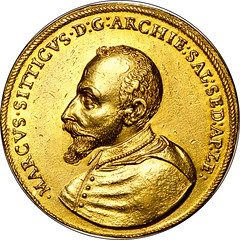 A 14 ducat of Salzburg
A 14 ducat of Salzburg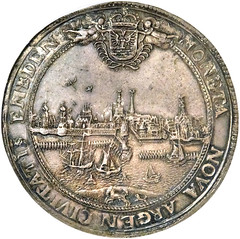 A 1672 ten ducat
A 1672 ten ducat
NUMISMATIC POSTCARDS PICTURING U.S. COINS
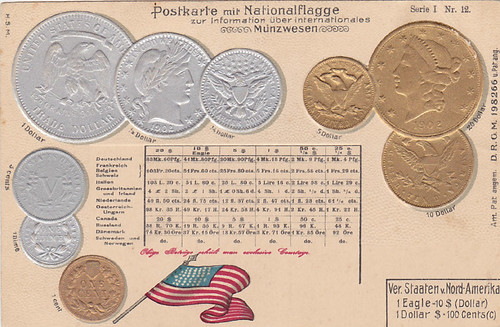
Semmler U.S. Embossing Die #1

Semmler U.S. Embossing Die #2
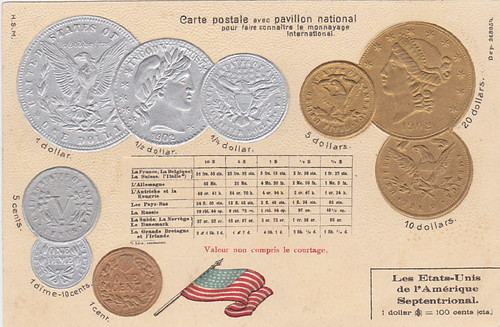
Semmler U.S. Embossing Die #3

Semmler U.S. Embossing Die #4
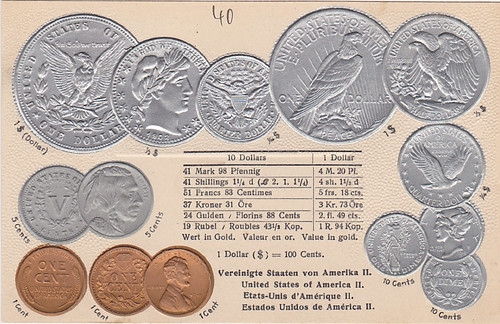 Erhard U.S. postcard #1 of 2
Erhard U.S. postcard #1 of 2
 Erhard U.S. postcard #2 of 2
Erhard U.S. postcard #2 of 2
300 DAYS OF FREE MEALS AND DRINKS
 A man bought a first-class ticket and used it to have free meals and drinks at an airport’s VIP lounge almost every day for nearly a year.
A man bought a first-class ticket and used it to have free meals and drinks at an airport’s VIP lounge almost every day for nearly a year.
FEATURED WEB PAGE: SATIRICAL COINS OF NAPOLEON III
This week's Featured Web Page was suggested by John Burns a few months ago: Les Monnaies Satiriques De Napoleon III (The Satirical Coins of Napoleon III).
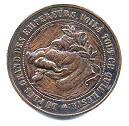
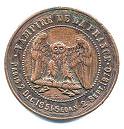
www.horizonfr.com/les_dossiers
_numismates/les_monnaies
_satiriques_de_napoleon_III.htm
